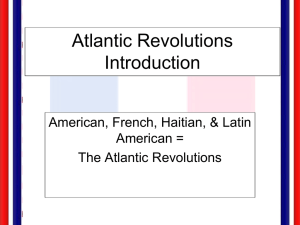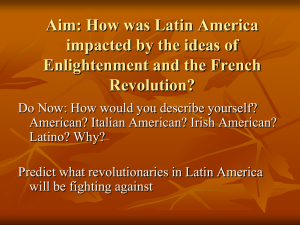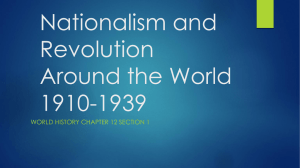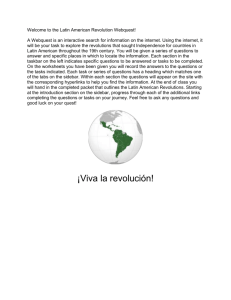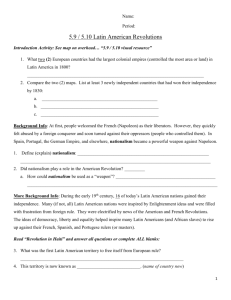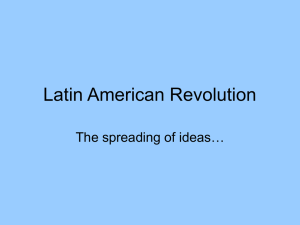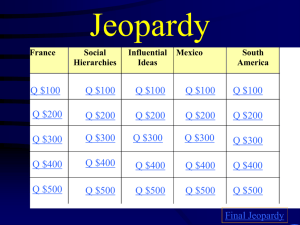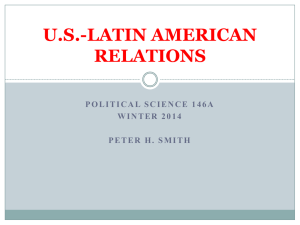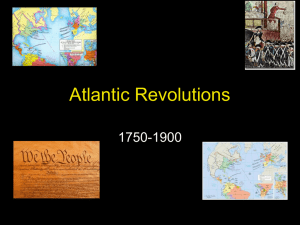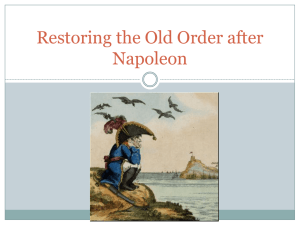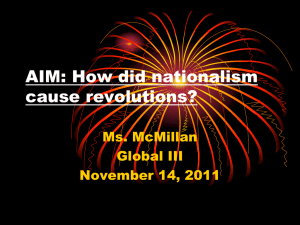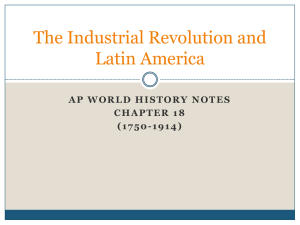Nationalism Review PowerPoint
advertisement
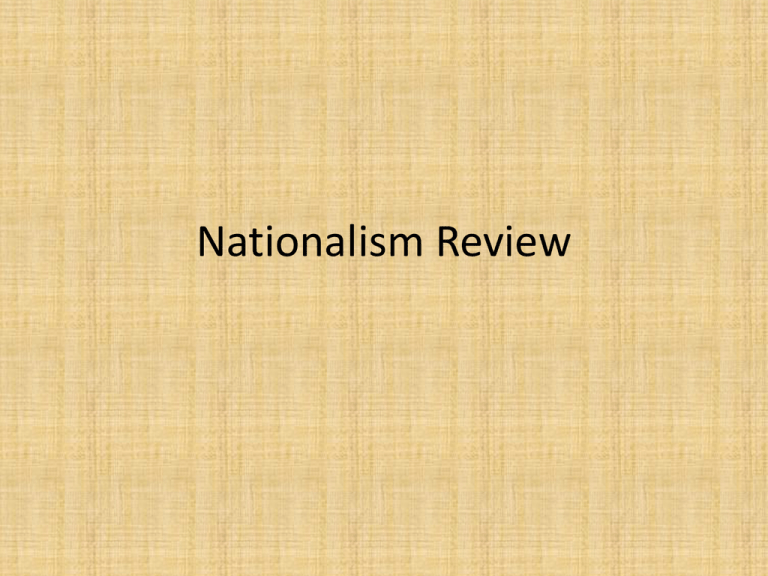
Nationalism Review • Simon Bolivar and Miguel Hidalgo, leaders of Latin American independence movements, were inspired by successful revolutions in – the Untied States and France – the Soviet Union and China – Cuba and Costa Rica – Egypt and Kenya 3pts • Explain how the Revolutionary War in the United States and the French Revolution are connected to nationalism in other parts of the world • During the early 1800’s, which was a major influence on the struggle for political independence in Latin America? – poor conditions in urban centers in Latin America – the American and French Revolutions – the desire of the Roman Catholic Church in Latin America to escape European control – demands by Latin American workers to own their own factories 5pts • Define the following (the 1800’s definitions) – Conservative – Liberal – Radical Document 2: Giuseppe Garibaldi, the “sword” of Italian unification, added the southern Kingdom of the Two Sicilies to Italy in 1861. He describes his “Red Shirts” with these words. Where any of our brothers are fighting for liberty, there all Italians must hasten! — such was your motto. Let him who loves his country in his heart, and not with his lips only, follow me. Question: What is Garibaldi trying to accomplish in this speech? 2pts • One similarity in the leadership of Latin Americas Jose de San Martin, Toussaint l’Ouverture, Bernanrdo O’Higgins, and Pedro I was that each leader – opposed United States intervention in Haiti – led a struggle to gain freedom for the people of his nation – opposed membership of his nation in the League of Nations – established an absolute monarchy in his nation “I will never allow my hands to be idle nor my soul to rest until I have broken the chains laid upon us by Spain.” • This statement was most likely made by – a Latin American nationalist – a Portuguese explorer – a Roman Catholic bishop – a Spanish conquistador 3pts • Put the following in the correct order you would find their status in a Spanish Colony – Native Americans – Peninsulares – Creoles – Mesitzos – Mulattos – Africans • Which of these situations was the direct result of the other three? – nations of Latin America won independence – revolutions occurred in North America and France – the Napoleonic wars weakened Spain’s power – creoles and mestizos became discontented with Spanish rule • The 19th-century independence movements in Latin America were influenced by – Marxist ideology – the Aztec wars against Hernando Cortez – liberation theology – the American and the French Revolutions 3pts • Briefly sum up the revolution in Haiti – Be sure to name the revolution’s leader • Simon Bolivar, Toussaint L’Overture, and Bernardo O’Higgins were Latin American leaders of – economic development – educational reforms – independence movements – colonial expansion 3pts • Briefly describe the revolution in Mexico – Be sure to mention at least one of the revolution’s leaders • In which region of the world did the American Revolution and the French Revolution have the greatest influence during the 1800’s? – Southeast Asia – Latin America – South Asia – sub-Saharan Africa • Simón Bolívar, José de San Martín, and Toussaint l’Ouverture are important in Latin American history because they were – 20th-century caudillos – leaders of liberation movements – members of the Organization of American States (OAS) – winners of the Nobel Peace Prize 5pts • Briefly describe the two main leaders of the Latin American nationalistic revolutions and their contributions. Use the following quote to answer the question. “A country is not merely a geographic territory. A country is also the idea given birth by the geographic territory. A country is a sense of love that unites, as one, all the sons and daughters of that geographic territory…” --World History: A Story of Progress • This quotation supports the idea of – – – – totalitarian rule absolute monarchy mercantilism nationalism Document 1: This excerpt is from Count Cavour who was named prime minister of Piedmont-Sardinia in 1852. As a diplomat, he provided the “brains” of Italian unification. We ardently wish to free Italy from foreign rule. . . . We want to drive out the foreigners not only because we want to see our country powerful and glorious, but because we want to elevate the Italian people in intelligence and moral development. Question: What action did Cavour recommend in this excerpt? 2pts • In a number of European countries in the 1800’s, which situation occurred as a result of the influence of the French Revolution? – increase in religious conflict – rise of nationalistic movements – decentralization of governmental power – economic depression • Nationalism is most likely to develop in an area that has – land suited to agriculture – adequate industry to supply consumer demands – a moderate climate with rivers for irrigation – common customs, language, and history • Nationalism is best defined as – the achievement of world peace and global understanding – the desire to take over other societies by force – a method of solving basic economic problems of the society – the loyalty of a people to their values, traditions, and a geographic region 2pts • Define impressionism Document 3: These words were spoken by Otto von Bismarck, who some people feel single-handedly unified Germany and started it on its road to greatness. He explains the process for unification of Germany. I had shown plainly the direction in which I was going. Prussia . . . could no longer carry alone the power that Germany required for its security. That must be equally distributed over all German peoples. We would get not nearer our goal by speeches, associations, or decisions by the majority. We would not be able to avoid serious contest with Austria. This contest could only be settled by blood and iron. There is one way to guarantee our success. The deputies must place the greatest possible weight of blood and iron in the hands of the King of Prussia. Question: Describe Bismarck’s method for uniting Germany. 2pts • The best example of the success of nationalism in Europe is the – development of socialism in France – Industrial Revolution in Great Britain – establishment of the Common Market – unification of Germany What country/region is each individual from? 1pt each • • • • • • • • • Simon Bolivar, Jose Maria Morelos Giuseppe Garibaldi Toussaint L’Overture, Otto von Bismarck Bernardo O’Higgins Count Cavour José de San Martín Miguel Hidalgo • Which was a major political change in Latin America in the 19th century? – The political power of the Roman Catholic Church was eliminated. – The right to vote was extended to all people. – Political power was no longer held by people of European ancestry. – Strong nationalistic feelings led to many new nations 2pts • Define realism • During the Latin American colonial period, political and economic power in most colonies under Spanish rule was held primarily by – parties representing workers and peasants – people who were born in Spain and their descendants – Indian tribal leaders – people of mixed Indian and Spanish ancestry Use the following quotes to answer the question. “Juarez Defeats French Troops in Mexico” “Bolívar Leads Revolutions in South America” “San Martin Liberates Argentina” These newspaper headlines refer to the emergence of • colonialism • nationalism • Marxism • mercantilism 2pts • Define romanticism Where are the Balkans? 5pts
